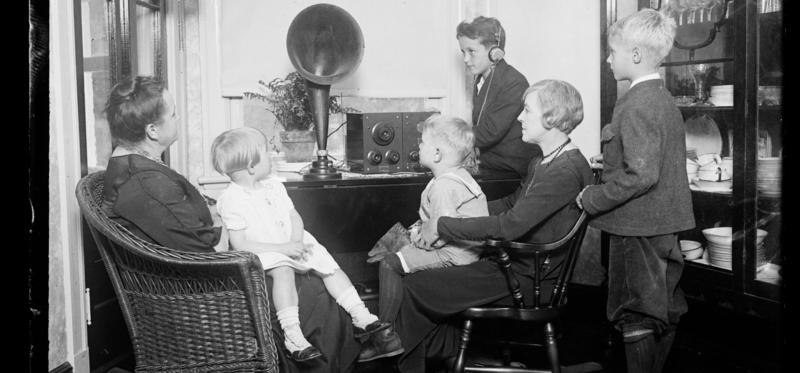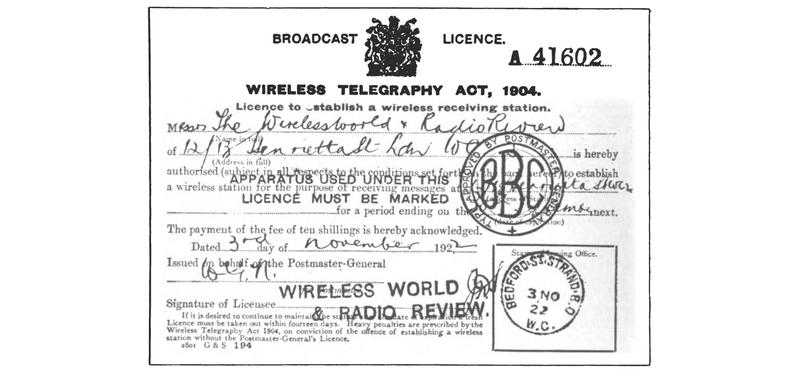Making Waves (original) (raw)
After World War One, Marconi‘s engineers wanted to explore the potential of wireless technology to educate and entertain
That meant moving away from the beeps of telegraphy and turning instead to the speech and music of telephony.
By 1920, the Marconi Company had developed the technology for this new form of radio broadcast.
The world was listening — but what would they hear?

Family listening to the radio, 1921. Library of Congress, Prints & Photographs Division, photograph by Harris & Ewing, LC-H234- A-9968.
The BBC
The BBC supplied the answer.
Then the British Broadcasting Company, it was founded in October 1922 by a group of wireless manufacturers including Marconi. The first daily broadcasts from Marconi’s London studio — which began only a month later — included news, music and dramatic readings.
One hundred years on, the BBC’s internet, television and radio content is enjoyed around the world.
To Educate and Entertain …
Advertised as Marconi’s most popular receiver, the V2 came onto the domestic market shortly after the BBC was founded.
https://view.genial.ly/629b72a6e733fb0010d4f605
Tuned in
Two listeners could each use headphones to hear the broadcast at the same time — or with the addition of an amplifier and speaker, the sound could fill the room for everyone to enjoy.
Tuned in
By 1930, over 3 million radio licences were in use — that’s roughly one in every two homes in the United Kingdom.
This is a licence for a radio receiver granted by the BBC — then part of the British Post Office — on 3 November 1922.

A licence for a radio receiver granted by the BBC — then part of the British Post Office — on 3 November 1922
Only receivers with a stamp like this were legal to sell in Britain. An annual licence cost 10 shillings — about £30 today.
Diva on the airwaves
World-famous soprano Dame Nellie Melba used this microphone in the first ever live musical radio performance, sent from a small packing shed at Marconi’s Chelmsford factory on 15 June 1920.
Tuned in
Marconi advertised the time and frequency of the performance ahead of time, which meant people all over Europe — and as far away as New York City — could hear and enjoy Melba’s performance.
The cone-shaped wooden mouthpiece funnelled the sound waves Melba’s voice created into the transducer, which converted them to electrical signals.
Those signals passed through the wire to a transmitter, which broadcast them over the wireless frequency.
Listen to the British Library's recording of Dame Nellie Melba's historic broadcast
Are you receiving me ...?
This small object was an alternative to the heavy, home-based radios that flooded the market in the 1920s.
At 1/50th of the cost of a full home system, it was also much more affordable.
Tuned in
The Baby Crystal Receiver has extremely simple circuitry and needs no power supply — just attach an aerial and an earth connection, plug in a pair of headphones and start listening!
On the Home Front
During World War II, radios became the centre of life on the home front.
Families could tune in to BBC news broadcasts and a range of programmes that lifted the national spirit.
After the war, domestic radios like this one brought public figures from the worlds of politics and show business into the homes of ordinary people.
The simple design and clear labelling made it easy to use.
Tuned in
The dials and display at the base of this radio allowed families to tune in to different radio frequencies, identified by place and 3-letter call sign. “Daventry”, which appears multiple times, was used for BBC broadcasts, including the:
- Light Programme (popular music)
- Third Programme (classical music), and
- The Home Service (news and current events).